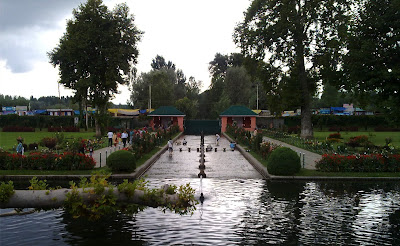Nishat Bagh
Visit to Nishat bagh was merely a coincident. Me and my friend was very tired of everyday schedule and we just wanted to cheer off a little bit. We took a walk off to Dal Lake after having our lunch. The weather was good to have a walk then we noticed a taxi there going to Nishat bagh. We instantly took decision that we have been to Dal lake a many times lets check out Nishat Bag this time. We took the taxi and reached to Nishat bagh. It took us about half an hour to reach Nishat bagh from Dal Gate. We took the tickets and entered Nishat Bagh. It was a splendid entrance built of grey sandstones surrounded by fountains and flowers showing the glimpse of Mughal Architecture. Mesmerising fountains and amazing water system were far more than fascinating. There is dal Lake in front of the Nishat Garden and a mountain range is in the backdrop of the Nishat Bagh which was surrounded by clouds that day. The view was amazing and it could not have been a better day to visit Nishat Bagh. A mixture of persian architecture and horticulture it reminded me of the breathtaking scenes in the video game "Prince of Persia" which i have played several times. After the visit of Nishat bagh i could only imagine the beauty of "Hanging Garedens of Babylon". I wished that if i could live in that time when the kings reigned over the kingdoms and life was much less busier than today.
Nishat Bagh , is a terraced Mughal Garden built on the eastern side of the Dal Lake, close to Srinagar in the state of Jammu and Kashmir, India. It is the second largest Mughal garden in the Kashmir Valley. The largest in size is the Shalimar Bagh, which is also located on the bank of the Dal Lake. ‘Nishat Bagh’ means "Garden of Joy", "Garden of Gladness" and "Garden of Delight."
Located on the bank of the Dal Lake, with the Zabarwan Mountains as its backdrop, Nishat Bagh is a garden of bliss that commands a magnificent view of the lake beneath the snow capped Pir Panjal mountain range that stands far away to the west of the valley. The Bagh was designed and built in 1633 by Asif Khan, elder brother of Nur Jehan.
 |
| The view of the mountains at the entrance |
 |
| Entrance gate in Persian Architecrure |
 |
| Serene view of fountains in Dal Lake |
 |
| The view of fountains at entrance |
 |
| A waterfall in Nishat Bagh |
 |
| Zabarwan mountains as backdrop |
 |
| Whole view of the Nishat bag with Zabarwan mountains as backdrop |
 |
| View of Dal Lake from the third terrace |
 |
| A tree fallen in the park |
 |
| A view of Dal Lake from second terrace |

















